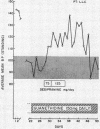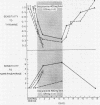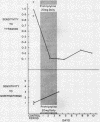Abstract
Antagonism of the antihypertensive action of guanethidine by the tricyclic antidepressants, desipramine and protriptyline, has been demonstrated in controlled studies. These antidepressants also prevent the effect of the related ring-substituted guanidinium adrenergic neuron blockers, bethanidine and debrisoquin. That the rise in blood pressure when desipramine is added to guanethidine therapy is not due simply to a pressor action of the two drugs in combination was demonstrated by the lack of an increase in blood pressure when guanethidine was added to desipramine therapy.
Investigations were conducted to determine whether antagonism of guanethidine's clinical effect could result from blockade by the tricyclic antidepressants of the norepinephrine pump in the adrenergic neuron membrane, thereby preventing the uptake of guanethidine into the neuron by this pump. Like guanethidine, the indirectly acting pressor amine, tyramine, enters the neuron via the norepinephrine pump. Desipramine, protriptyline, and amitriptyline in clinical doses all were found to block the pressor action of tyramine while potentiating the pressor effect of norepinephrine. The amino acid, methyldopa, does not enter the neuron via the norepinephrine pump, and its antihypertensive action is not altered by concomitant administration of tricyclic antidepressants. It is concluded from the evidence in this investigation together with the results of previous studies in experimental animals that clinical doses of desipramine-like drugs inhibit the norepinephrine pump in the peripheral adrenergic neuron in man and thereby prevent uptake of guanethidine to its site of action.
Full text
PDF


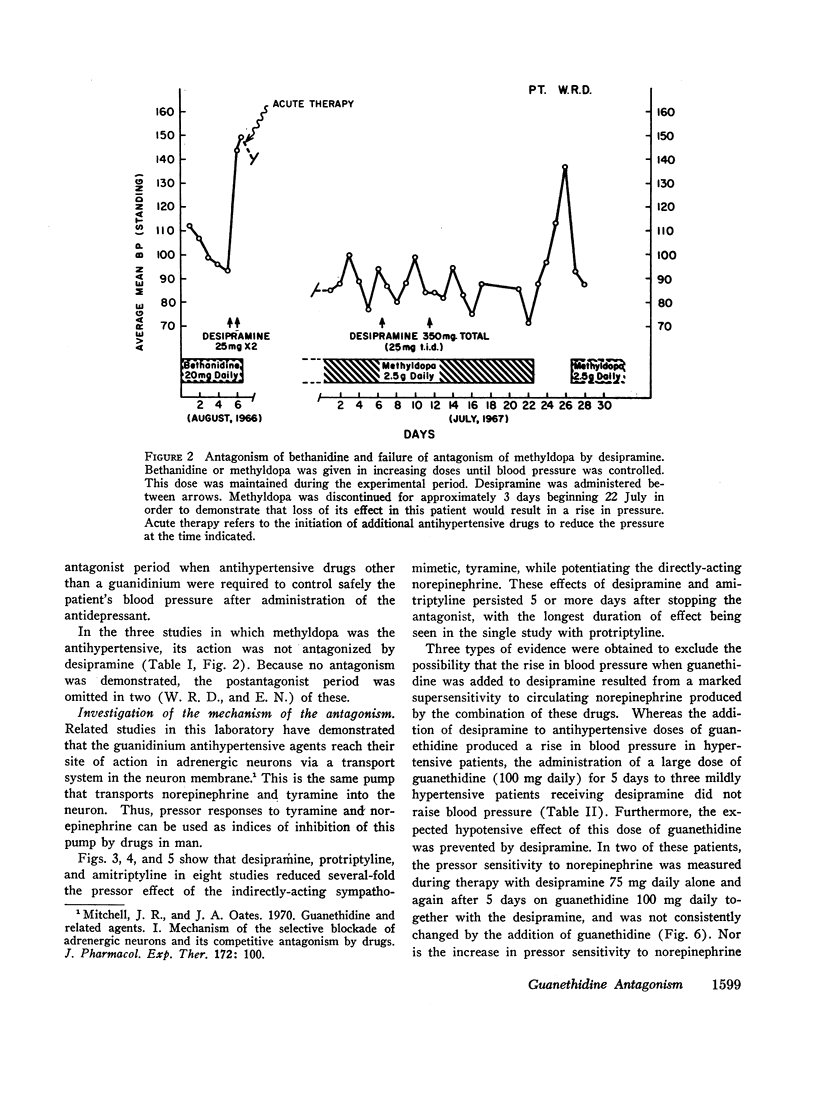

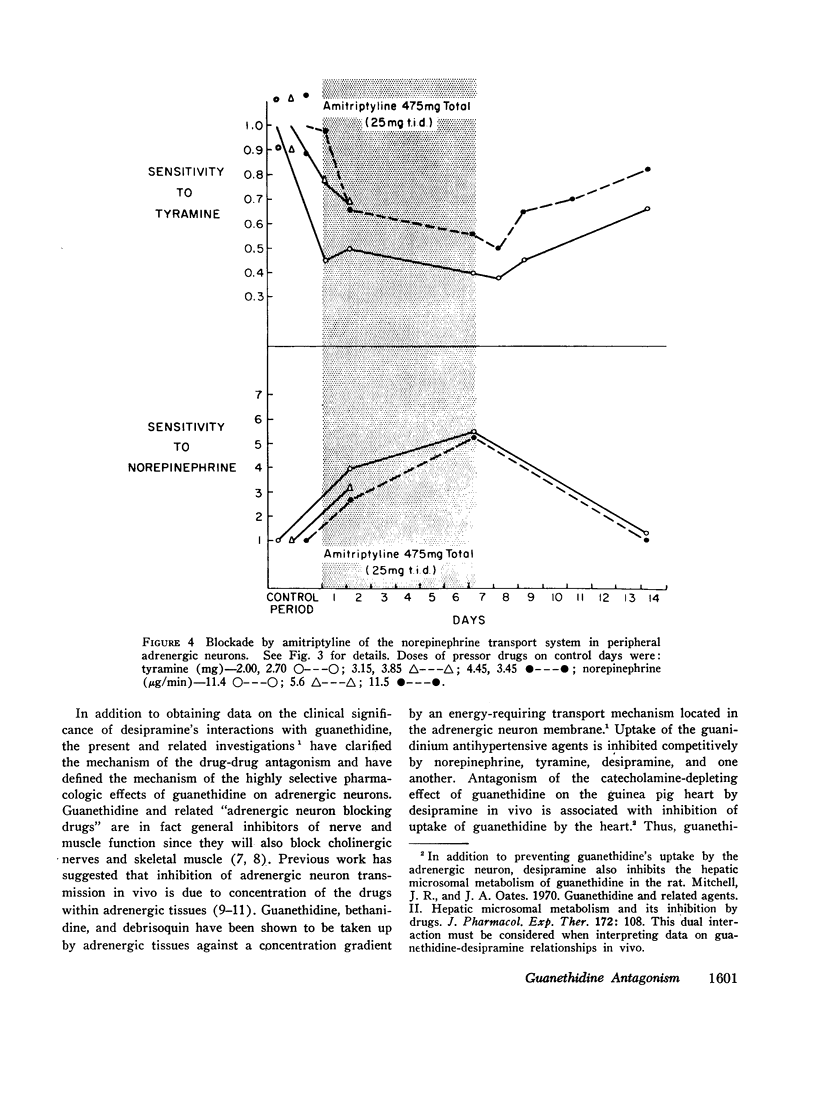


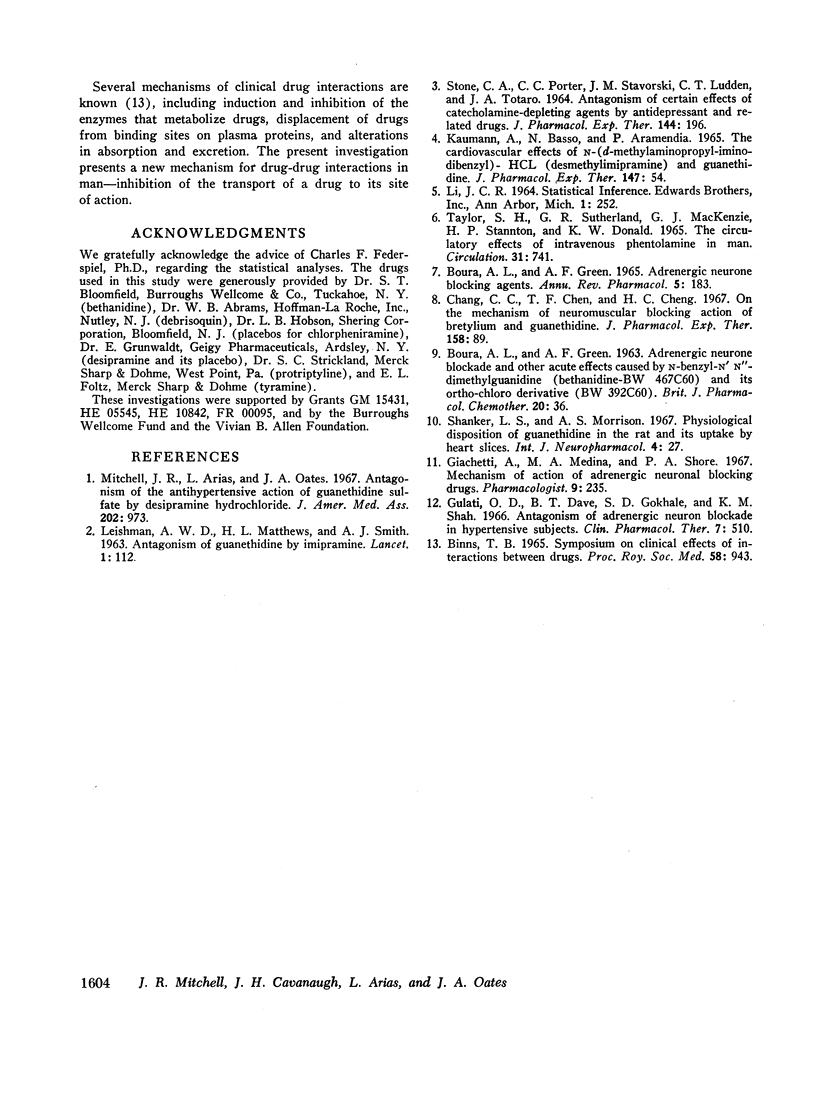
Images in this article
Selected References
These references are in PubMed. This may not be the complete list of references from this article.
- BOURA A. L., GREEN A. F. ADRENERGIC NEURONE BLOCKING AGENTS. Annu Rev Pharmacol. 1965;5:183–212. doi: 10.1146/annurev.pa.05.040165.001151. [DOI] [PubMed] [Google Scholar]
- BOURA A. L., GREEN A. F. Adrenergic neurone blockade and other acute effects caused by N-benzyl-N'N"-dimethylguanidine and its ortho-chloro derivative. Br J Pharmacol Chemother. 1963 Feb;20:36–55. doi: 10.1111/j.1476-5381.1963.tb01295.x. [DOI] [PMC free article] [PubMed] [Google Scholar]
- Chang C. C., Chen T. F., Cheng H. C. On the mechanism of neuromuscular blocking action of bretylium and guanethidine. J Pharmacol Exp Ther. 1967 Oct;158(1):89–98. [PubMed] [Google Scholar]
- Gulati O. D., Dave B. T., Gokhale S. D., Shah K. M. Antagonism of adrenergic neuron blockade in hypertensive subjects. Clin Pharmacol Ther. 1966 Jul-Aug;7(4):510–514. doi: 10.1002/cpt196674510. [DOI] [PubMed] [Google Scholar]
- KAUMANN A., BASSO N., ARAMENDIA P. THE CARDIOVASCULAR EFFECTS OF N-(GAMMA-METHYLAMINOPROPYL-IMINO-DIBENZYL)-HCL (DESMETHYLIMIPRAMINE) AND GUANETHIDINE. J Pharmacol Exp Ther. 1965 Jan;147:54–64. [PubMed] [Google Scholar]
- LEISHMAN A. W., MATTHEWS H. L., SMITH A. J. Anatgonism of guanethidine by imipramine. Lancet. 1963 Jan 12;1(7272):112–112. doi: 10.1016/s0140-6736(63)91123-1. [DOI] [PubMed] [Google Scholar]
- Macgregor A. G. Clinical effects of interaction between drugs. Review of points at which drugs can interact. Proc R Soc Med. 1965 Nov;58(11 Pt 2):943–946. [PMC free article] [PubMed] [Google Scholar]
- Mitchell J. R., Arias L., Oates J. A. Antagonism of the antihypertensive action of guanethidine sulfate by desipramine hydrochloride. JAMA. 1967 Dec 4;202(10):973–976. [PubMed] [Google Scholar]
- Mitchell J. R., Oates J. A. Guanethidine and related agents. I. Mechanism of the selective blockade of adrenergic neurons and its antagonism by drugs. J Pharmacol Exp Ther. 1970 Mar;172(1):100–107. [PubMed] [Google Scholar]
- SCHANKER L. S., MORRISON A. S. PHYSIOLOGICAL DISPOSITION OF GUANETHIDINE IN THE RAT AND ITS UPTAKE BY HEART SLICES. Int J Neuropharmacol. 1965 Feb;4:27–39. doi: 10.1016/0028-3908(65)90044-4. [DOI] [PubMed] [Google Scholar]
- STONE C. A., PORTER C. C., STAVORSKI J. M., LUDDEN C. T., TOTARO J. A. ANTAGONISM OF CERTAIN EFFECTS OF CATECHOLAMINE-DEPLETING AGENTS BY ANTIDEPRESSANT AND RELATED DRUGS. J Pharmacol Exp Ther. 1964 May;144:196–204. [PubMed] [Google Scholar]
- TAYLOR S. H., SUTHERLAND G. R., MACKENZIE G. J., STAUNTON H. P., DONALD K. W. THE CIRCULATORY EFFECTS OF INTRAVENOUS PHENTOLAMINE IN MAN. Circulation. 1965 May;31:741–754. doi: 10.1161/01.cir.31.5.741. [DOI] [PubMed] [Google Scholar]



